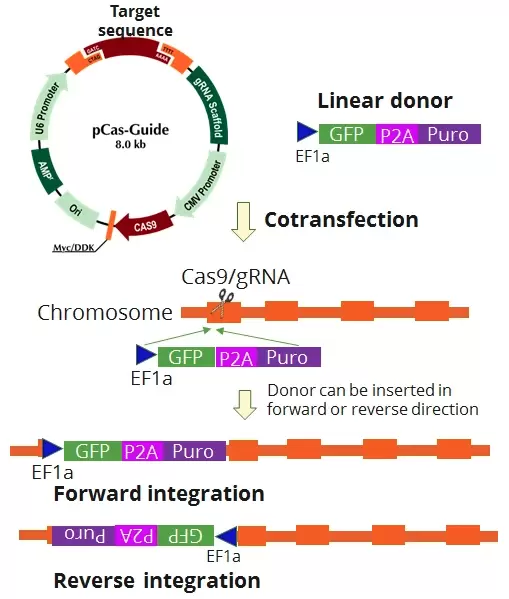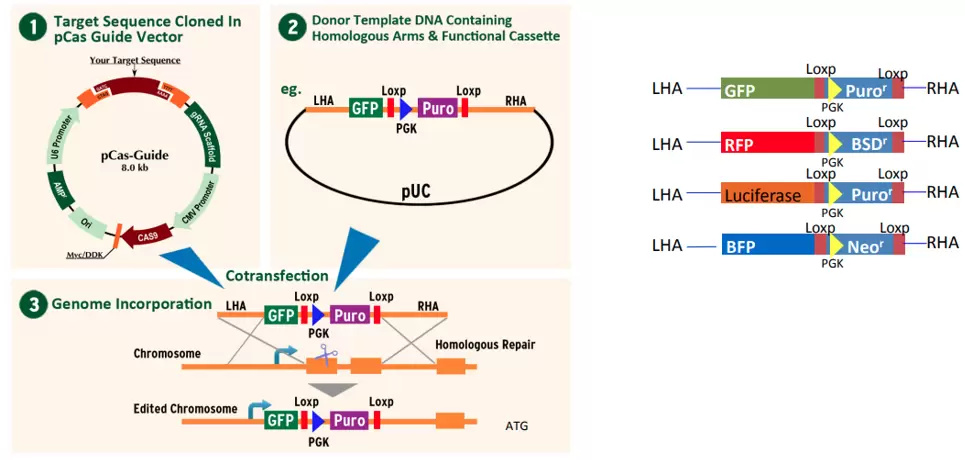
CRISPR Kits
CRISPR/Cas9 Gene Knockout Kits with Donor Template
Human and Mouse Genome-Wide Gene Knockout
CRISPR/Cas9 is a simple and efficient genome editing tool. Although gene knockout cell lines can be generated by gRNAs without donor vector, the screening process can be very tedious. Our partner OriGene has developed genome-wide CRISPR gene knockout kits containing 2 gRNA vectors and donor DNA. The selection marker in the donor cassette greatly facilitates the screening process.
Two types of CRISPR knockout kits are offered, differing in the repair mechanism that is used to achieve gene knockout, homology based or non-homology based. HDR-mediated CRISPR/Cas9 Gene Knockout Kit is the first generation gene knockout kits, gene knockout is achieved via homology-directed repair (HDR). KN2.0 CRISPR/Cas9 Gene Knockout Kit is an improved version, gene knockout is achieved via non-homology based repair. KN2.0 CRISPR/Cas9 Gene Knockout Kit is more efficient and works in both dividing and non-dividing cells.
Comparison HDR-mediated CRISPR/Cas9 Gene Knockout Kit vs. non-homology mediated KN2.0 CRISPR/Cas9 Gene Knockout Kit

KN2.0 non-homology mediated CRISPR/Cas9 Gene Knockout Kits
The KN2.0 CRISPR/Cas9 Gene Knockout Kits are more efficient and work in both dividing and non-dividing cells. Gene knockout is based on non-homology-mediated repair mechanism. After gRNA targeted double stranded DNA cleavage, the linear donor DNA containing a selection cassette will be integrated at the gRNA cutting site at forward or reverse direction. Testing data using KN2.0 kits showed that the vast majority gene knockout is biallelic, one allele contains donor integration, the other allele has indels (insertion and deletion), which might change protein coding or cause premature stop.
- Ready-to-use gene knockout kit
- 2 guide RNA vectors in pCas-Guide to ensure efficient cleavage
- Donor cassette, EF1a-GFP-P2A-Puro
- Non-homology mediated gene knockout
- Highly efficient gene knockout kit
- KN2.0 Knockout Kit Validation
How It Works

HDR-mediated CRISPR/Cas9 Gene Knockout Kits
Using HDR-mediated CRISPR/Cas9 Gene Knockout Kits, gene knockout is achieved via homology-directed repair (HDR) mechanism. Donor vector contains homologous sequences flanking the selection cassette. After gRNA targeted double stranded break, donor cassette is inserted in the genome via homologous repair immediately downstream the native promoter.
- Complete kit for gene knockout via CRISPR (targeted sites around the 5’ end of the ORF)
- 2 guide RNA vectors in pCas-Guide to ensure an efficient cleavage
- Donor vector with predesigned homologous arms
- pCas-Guide-scramble is also provided as a negative control
- 4 different donor selection cassette available for each gene
- HDR-mediated Knockout Kit Validation
How It Works

1 CRISPR/Cas cuts the double-stranded DNA at the targeting site. 2 Donor template DNA provides the template for the homologous repair. 3 The functional cassette is incorporated into the genome when 1 + 2 are cotransfected. Donor vector for each kit contains around 600 bp locus-specific homologous sequence on each side of the donor selection cassette. LHA – left homologous arm, RHA – right homologous arm. Four different donor cassettes are offered for each gene.